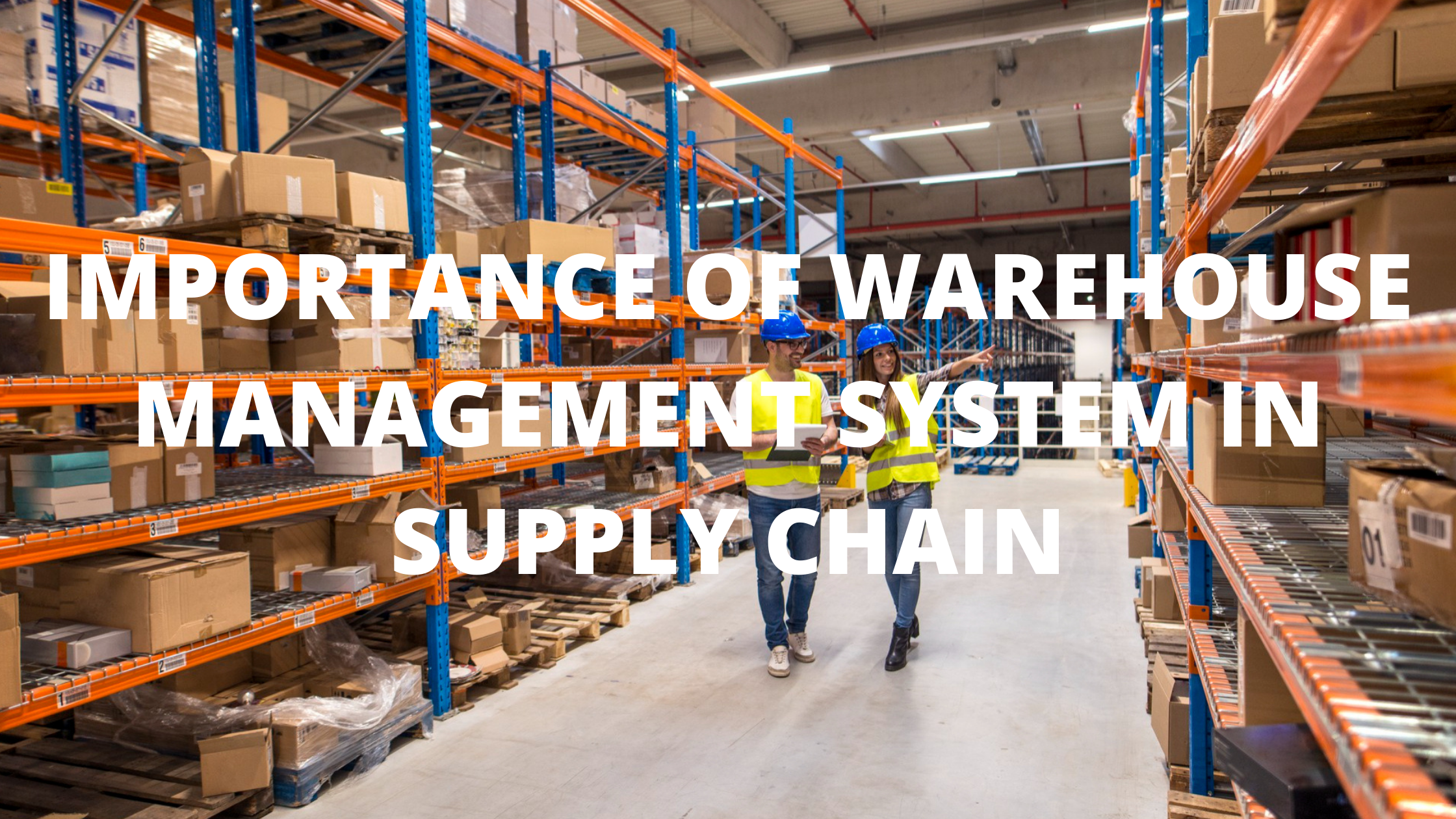Importance of warehouse management system
The flow of goods and services from raw materials to production to completed products supplied to consumers is referred to as a supply chain. A business’s supply chain will not function correctly without a warehouse to store all of the goods and products. Warehousing is an important component of the supply chain since it guarantees that logistical duties are completed swiftly and efficiently. Without a sophisticated Warehouse Management ERP System that can eliminate all obstacles, such as irregular supplies, delayed sourcing, and more, managing a free-flowing logistics supply chain is challenging. A warehouse that is integrated with ERP software can accurately and efficiently provide all items and services.
A warehouse management system is a platform that is primarily used to monitor and oversee the warehouse’s everyday activities. It encompasses a broader range of material requirements, from material monitoring and tracking to delivery to end users. A Warehouse Management System (WMS) is a specialized internal system used by logistics organizations to regulate and manage storage, distribution, and other activities. Inventory balance, materials management, pick-up process, and auditing are all aided by a sophisticated WMS.
Ecommerce accounted for roughly 23% of overall storage space taken up in 2018, according to a CBRE analysis, and is predicted to grow by 9% by 2025. This demonstrates the importance of storage in the ecommerce supply chain management process, and its significance in the supply chain industry will grow in the next few years. Warehouse Management Systems allow users to consolidate various warehouse management tools and duties through a single material handling system, ensuring ease of use and operational efficiency for complicated supply chains. Furthermore, the WMS tools will improve the supply chain process’ visibility.
WHAT ARE THE PROCESSES INVOLVED IN A WAREHOUSE MANAGEMENT?
The backbone of how a material is converted into products and supplied to clients is a well-connected distribution network. The processes of getting materials into your business and subsequently distributing the finished product to clients, on the other hand, are distinct. The terms “inbound logistics” and “outbound logistics” are used to describe these activities. It’s critical to know the difference between the two in order to have a complete picture of your Warehouse Management System logistics network and increase supply chain visibility:
Inbound logistics process
Inbound logistics is a specialized network of services that comprises everything your supply chain operations require to complete the final product. It also transports materials or products to your place of business. Transport, storage, and delivery to your business are all included. Let’s take a look at how the inbound mechanism functions:
Purchasing materials
WMS maintains vendor details in a single location during the buy process and synchronizes them to real inventory control levels to handle procurement using its enhanced features. By scanning the barcode, the commodity or product will be added to the list automatically. Following that, customers will receive their invoice via email from the device to the shop.
Receiving
A warehouse management system (WMS) can scan and optimize receipts while also directing warehouse employees to the appropriate shelf location. Along with his WMS, he has a variety of ways for putting things away, slotting, and making optimum use of storage space.
Reverse logistics
The Warehouse Management System alerts managers to the quantity of available products. It also informs the administrator when replenishing is required. This allows the administrator to order more supply in order to avoid future shortages.
Outbound logistics process
As digital innovations continue to reshape the sector, excellence is expanding outside global borders, as are export processes. What exactly are these outbound logistics processes, though? Storage, transportation, and delivery methods are all part of outbound logistics and warehouse management, which will get your finished products to their final destination. The steps of the outbound logistics mechanism are as follows:
Order picking
In a traditional warehouse management system, missing or inaccurate shipping or delivery is frequently caused by a lack of data and ineffective tracking. This can be risky, but using WMS SOFTWARE that is efficient and effective ensures that the best product is selected. It also makes use of barcode scanners or RFID scanners to ensure that the proper WMS items are available.
Product packaging
To optimize the packing channel, product packaging must be automatically distinguished from one size to the next using warehouse management technologies. Shipping labels, price tags, logos, and other required documents may all be produced directly from the computer, eliminating the need for human involvement to input addresses or re-type tracking numbers.
Delivering finished products
The Warehouse Management System guarantees that your orders are delivered on time to the correct clients and alerts them of this. The faults can be corrected during the selection and dispatch process. In this approach, you can provide the highest level of client satisfaction while also fulfilling your high-value incoming and outbound orders. For the goal of outsourcing fulfillment, companies might enlist the help of third-party logistics suppliers.
LIMITATIONS OF USING TRADITIONAL WAREHOUSE SYSTEMS IN YOUR BUSINESS
Traditional systems are risky because, as order volume grows, the complexity of receiving and delivering orders grows as well. Because businesses may extend their product offers, warehouse management systems must react to the changing inventory flow. By tracking orders inaccurately, poor warehouse logistics and inventory management systems may drain the organization’s costs. Aside from that, there are certain disadvantages to adopting traditional warehouse systems, which are as follows:
- Barcode durability
- Warehouse order picking carts
- Lengthy quality checks
- Product pilferage
- Wastage of time
- Rigid documentation
- Human errors
Barcode durability
When efficiency is enhanced by lowering the mispick rate, older versions of barcode scanners might be clunky and sluggish to work. They usually have a small reading zone and can’t scan items that are too far away or too high up. These scanners also need assistance to use at least one hand, which limits their ability to accomplish other activities. Because there are several barcodes to choose from, or because the barcodes are difficult to see or erroneous, certain items require multiple scans. Furthermore, the barcode symbols necessitate the use of suitable barcode readers. Most 1 dimensional barcodes can be read by conventional barcode scanners; however 2 dimensional barcodes require more complex scanning machines.
You check each device at each access point within your network system to avoid this problem. This will reveal various infrastructural flaws, allowing you to devise fixes accordingly. If resources are limited, patching is a viable option, since it allows you to concentrate on assets with the highest risk levels.
Warehouse order picking carts
Picking methods based on person to goods methodology are commonly used in traditional warehouses. Employees go around the warehouse looking for SKUs (Stock Keeping Units) on their order list. They put each item in order picking carts and move them around till they find the next SKU. They return these carts to the sorting or packaging stations after choosing all of the things on their lists. These carts are heavy and difficult to maneuver; especially when they are full. Workers are put under physical strain in these environments because they must push these carts through the warehouse until all of the things have been gathered. Because the staff travel around at a slower pace than the typical walking speed, these carts will slow down overall production and increase the time spent filling orders. Employees must memorize item locations in addition to the physical strain, resulting in greater mental stress and the risk of human error due to weariness.
Lengthy quality checks
In the case of a standard logistics warehouse management system, the process of checking product quality is sometimes slow and monotonous. The goods must pass through a number of quality inspections, which adds time to the whole process. The first step in resolving this issue with quality checks is to specify the quality defect tolerances in your product quality control manual. It should also be verified that your suppliers are transparent in order to obtain higher-quality goods and set prices that are acceptable to them.
Product pilferage
Product pilferage occurs when a shipment is stolen or sections of a box are resealed with false contents. Pilfering tiny packages from a bigger shipment, such as a shipping container, is also possible. Product pilferage also includes difficulties such as stealing the complete box, stealing a pallet, shoplifting, and stealing a truck load, among others.
Theft in the Warehouse Management System might have a negative impact on your company’s supply chain. The scenario has changed now, as the new warehouse management system assists you in maintaining inventory control by giving correct data. This will aid in the elimination of fraud by providing real-time data on your inventories.
Wastage of time
Many warehouses, with pallets traveling through several sites, may be affected by unwanted and excessive product handling. Furthermore, surplus operations may be less visible. Duplicate data entry and duplication of information are two instances of such actions. When confronted with such situations, a lean exercise will be beneficial. This will eliminate production and manufacturing downtime. Within the workplace environment, approval with notifications can ensure that decisions and approvals are made fast.
Rigid documentation
The foundation of the warehousing method is documentation. The company must manage a large number of documents, which can be a major headache at times. Traditional warehousing procedures make it difficult to store everything because receipts can go missed or someone can tether it.
WMS will aid in the automated forward and backward picking of your parcels from large orders. It also gives sales velocity data, which allows the administrator to determine the amount of the advance storage pick according to the item, reducing the number of superfluous replenishment jobs and automating the stock moment.
Human errors
Human errors are unavoidable in any organization, and traditional warehouses are no exception. The majority of processes in traditional warehouses rely on human effort. Human errors can have a negative influence on profitability and possibly result in fatal injuries. A good warehouse management system can help you avoid mistakes like this. To avoid such dangerous situations, automate your forklifts and build a retrieval process. Aside from that, warehouse management automation aids in lowering the number of repetitive jobs that can cause significant damage.
BENEFITS WAREHOUSE MANAGEMENT SYSTEM IN SUPPLY CHAIN
- Sustainable Inventory Management
- Effective labor
- Transparency in reporting
- ROI
- Efficient picking
- Increased productivity
- Price stabilization
- Improved relations with customers and suppliers
- Reduction in paperwork
- Timely shipping
- Centralized platform
- Internal automation benefit
Sustainable Inventory Management
A well-run warehouse can give you a consolidated inventory tracking system. You can more efficiently store, package, and distribute products, as well as process any incoming orders. According to research, around 34% of businesses shipped orders late because they sold products that were not in stock. These kinds of mistakes can slow down your entire procedure by many folds. Due to delayed deliveries, it might also have a negative influence on the customer experience. A good inventory management system combined with a well-thought-out storage strategy can provide your company a competitive advantage. You can always check your inventory and refill when you run out of goods, and you can always stay up to date on the SKUs in your warehouse with these kinds of technologies in place.
You may use sophisticated inventory management software to carry out all of these processes without any problems. You’ll have no trouble taking your products if you have them all in one spot.
Effective labor
A warehouse management system (WMS) can give the correct work to the right person at the right time, taking into account their skill levels, proximity in the warehouse, equipment, and available warehouse tasks. The optimization of journey time within the warehouse is one of the finest benefits that the WMS can bring for improved labor utilization. The WMS can direct workers to the most impactful activities while also identifying the best laborer for the job.
The system may assign jobs on a daily basis and efficiently construct schedules using labor predictions. Scanning things as they enter and exit a warehouse, as well as during their motions, can reduce the need for double-checking, saving time and speeding up the recording process. Scanning can enhance pick accuracy and consequently improve customer service by eliminating miss-picks. Staffing can also be analyzed using KPIs, which is important because labor is generally one of the largest costs in warehouse operations. Labor efficiency, equipment efficiency, and space efficiency can all be improved with proper task assignment.
Transparency in reporting
One of the most important features of a WMS in the supply chain and logistics industry is the ability to recognize problems faster and respond quickly. When a vendor in the supply chain network is unable to fulfill orders on time, the WMS notifies all of the chain’s connected users as soon as the information is updated in the system. This gives businesses enough time to discover an alternate source without causing or informing customers of a potential delay.
ROI
With improved sales and profits, an excellent WMS solution will quickly accelerate your ROI. It’s a good fit for your company because it allows you to market to your satisfied consumers faster and more accurately. Furthermore, the accurate and intelligent solution is less prone to errors, resulting in increased customer satisfaction.
Efficient picking
Picking is a difficult process that demands extreme accuracy. If not handled properly, you risk sending the wrong package to your clients, which could have a severe influence on your business. In addition, if you have to deal with fragile things, incorrect packaging might cause the products to be damaged, resulting in increased economic losses. As a result, you must keep all of your products in good working order. So you can quickly find them and pick them up at their designated location. For example, if you offer gadgets with comparable specifications, such as mobile phones, an Apple iPhone SE 2020 and an iPhone 8 are readily confused. This may result in an unfavorable comment about your service. A warehouse with appropriately arranged racks and bins, as well as automated software to locate products, can help to avoid such problems.
Increased productivity
Warehouse Management System improves warehouse efficiency, material flow, uniformity, and quality control at lightning speed. Every stage of the fulfillment process is improved by the cloud-based solution, and jobs are generated in a fraction of the time. Furthermore, the approach improves shipment accuracy while lowering labor productivity.
Price stabilization
By holding your products for a longer period of time, the warehouse helps you maintain regular stock levels and maximize earnings. Depending on the season and area, you can buy things in bulk and sell them throughout the year. If you’re an apparel retailer, for example, instead of putting winter items on sale and losing money, you may store it in your warehouse and resell it next season. Government policies change frequently, giving you the opportunity to reprioritize your items. This can help you make more money because you won’t have to replenish inventory as often.
Improved relations with customers and suppliers
The benefits of warehouse management systems are not confined to businesses, but extend far beyond them. These systems can optimize the entire logistics and supply chain thanks to their high monitoring capabilities, which is the most evident benefit for suppliers and vendors. Customers, on the other side, benefit from speedier product delivery and fewer order inaccuracies. As a result, WMS software aids in the enhancement of your company’s reputation among consumers and suppliers.
Reduction in paperwork
An automated WMS can have a significant influence on paper usage. Real-time updates significantly decrease paperwork and ensure that inventories and information flow in perfect harmony. You can also get rid of the old techniques of information storage because it can now be done digitally.
Timely shipping
You can streamline your delivery from a single place with the help of a warehouse. There will be less confusion and you can quickly lower the TAT (Turn Around Time) for your first mile operations if your products are stocked, chosen, and packaged in one location. In addition, the location of your warehouse has a significant impact on order delivery timeliness. You can deliver your order in a timely manner if your warehouse is close to the purchasers’ location. This will also help you save money on shipping by preventing purchases from being returned due to late deliveries. As a result, with a well-designed warehouse, you can easily optimize both first- and last-mile operations.
platform
WMS software provides a single platform for tracking, monitoring, and managing all logistics and supply chain processes. It integrates all storage, shipping, and distribution divisions to close the information gap and reduce friction between providers. As a result, a continual flow of commodities in and out is ensured, resulting in a well-functioning logistics supply chain system.
Internal automation benefit
Within a warehouse, warehouse management systems enable the application of further automation technologies. Internal work assignments can be automated and mobile devices can help with the shift from paper to electronic work and activity recording. This method simplifies the process, making it easier to scale and ensuring data accuracy. Because access can be supplied through portable mobile devices, mobile pairing with the WMS can allow the input procedures to be enhanced.
Automation helps the company improve its present operations by implementing better tactics. There are several levels of automation available, including automated picking and packing, robotics, analytics-driven movements, and Artificial Intelligence (AI). These tactics are aided by warehouse management systems, which provide the essential elements for capturing, recording, and communicating activity. Sensors, barcoding, pick-to-light, voice, and automated carousels, for example, can all help enhance throughput by monitoring picking and packing activity when coupled with a WMS. Robots and automated conveyors can help to streamline processes and eliminate bottlenecks.
FINAL THOUGHTS
The backbone of your supply chain management operation is warehousing. It is where all of the primary fulfillment procedures are carried out. As a result, you must be cautious when selecting a WMS and meticulously execute all processes from beginning to end. As previously said, a WMS has a number of advantages that will assist you in optimizing your supply chain and increasing your success and profitability. Additionally, you can assure effective routing, personnel allocation, and space and time savings. You must examine the ROI and overall expenditures while selecting one that will meet your specific business needs. A well-equipped WMS system is intended to have a positive impact on your logistics supply chain operations. It helps your brand establish a trusted provider of goods and services, gain a reputation, and boost client retention by improving consistency in delivering quality services.








